Reduce Light Pollution with Better Outdoor Lighting
Have you ever walked around your neighborhood at night and noticed the amount of wasted, and oftentimes unnecessary, artificial light? I think we have all noticed the poorly designed outdoor lighting in our neighborhoods that contributes to light pollution.
According to the DarkSky International (IDA), light pollution is increasing at two times the rate of population growth with 83% of the global population living under a light-polluted sky. In fact, researchers reported that people living in urban areas of more than 500,000 people are exposed to night-time light levels that are three to six times brighter than people in rural areas (BBC).
Our night sky is fading – with fewer and fewer dark places to experience a sky full of stars. In the following video, I share some examples of the most common poor outdoor lighting options found in my city.
What is Light Pollution?
Light pollution is defined as the inappropriate use of artificial light at night. Not only is it an environmental pollutant that has potential harm to human health and negatively impacts our wildlife and ecosystems, but it robs us of the opportunity to experience the wonder of a truly dark night sky.
As an amateur astrophotographer, light pollution directly hinders my ability to effectively photograph the night sky from my backyard in the city. Astronomers use a variety of tools to measure sky brightness for astronomical purposes including the Bortle Scale.
The good news? Light pollution, unlike other forms of pollution, can be reversed. There are actions you can take right now that will have an immediate and long-lasting effect, including choosing responsible outdoor lighting.
Light pollution before and after from the suburbs of Toronto during the 2003 blackout. DarkSky/Photo by Todd Carlson
5 Principles for Responsible Outdoor Lighting at Night
As a solution to this global problem, the IDA and the Illuminating Engineering Society (IES) have published ‘Five Principles for Responsible Outdoor Lighting’. Their shared goal is to prevent and reduce light pollution through the proper application of quality outdoor lighting. The five principles include:
- Useful: All lighting should have a clear purpose
- Targeted: Lighting should be directed only where it is needed
- Low Levels: Light Should be no Brighter Than Necessary
- Controlled: Light Should Only be Used When Useful
- Color: Use Warmer Colour Lights
By applying these principles, properly designed lighting at night can be beautiful, healthy, and functional. You will also save energy/money, minimize wildlife disruption, and reduce light pollution.
1) Useful: All Light Should have a Clear Purpose
Before installing a new light or replacing an old, ask yourself if you need it. More and more people are using outdoor lighting as decoration because it ‘looks nice’ rather than it serving a clear purpose. When lighting does not have a clear purpose, we often end up using too much.
When choosing or installing a light fixture, consider how it will impact the area (i.e. wildlife and the environment). Also consider if there are any alternatives to using outdoor lighting fixtures, such as reflective paints or self-luminous markers.

2) Targeted: Light Should be Directed only Where Needed
All lighting should be targeted and directed to light up only the intended area. If you have determined that a light is needed, it should be properly targeted to serve its intended purpose.
Use shielding and careful aiming to target the direction of the light beam so that it points downward and does not spill beyond where needed.
Examples of targeted light fixtures
Did you know that 20% – 50% of outdoor residential lighting is lost to the night sky due to poor shielding alone? Using outdoor lighting with proper shielding alone can make a big difference in reducing light pollution (DarkSky).
There are many negative impacts that result from outdoor lighting that is not properly targeted; including light glare, light trespass, public safety, and wasted energy.

Light Glare
Light glare is an intense light that hits your eye and disrupts your ability to see properly. It is the result of lighting that is not shielded or directed down toward the ground. It can come from a variety of light sources (i.e. street lights, a neighbour’s light, a nearby business, etc.).
In some cases, glare from unshielded lights can impact your safety and security at night. Not only does the light shine into your eyes making it more difficult to see what is in front of you, but it also makes it difficult for your eyes to adjust to lower light conditions.
Examples of bad/harsh light glare that is hard on the eyes
Light Trespass
The situation is similar for light trespass, which is light from unshielded fixtures that spill into areas where it is not intended. The most common examples of this would be a bright street light or an outdoor light from your neighbour’s property shining onto your property or through your window at night.
All living things need a day/night cycle, known as circadian rhythm. Loss of sleep and disturbance of the circadian rhythm from light trespass at night can lead to a wide variety of
serious health concerns, including irritability, digestive problems, stress, inability to concentrate or focus, depression, etc.
Examples of bad light trespass and light spilling into windows and other areas
Public Safety
Many people believe that more and brighter outdoor lighting creates safer environments, but there is no conclusive evidence suggesting that’s true. In fact, glare from unshielded lights can create harsh shadows where criminals can hide.
Here are a few studies that suggest more/brighter light does not mean increased safety:
- The effect of reduced street lighting on road casualties and crime in England and Wales: controlled interrupted time series analysis: Lighting had no effect on road traffic collisions, whether lighting was turned off completely, dimmed, turned off at certain hours or substituted low-power LED lamps.
- The Chicago Lighting Alley Project: Showed a correlation between brightly lit alleyways and increased crime.
- Human and Environmental Effects of Light Emitting Diode (LED) Community Lighting: Glare from nighttime lighting can create hazards ranging from discomfort to frank visual disability.
The problems of light glare and trespass are solved when outdoor lighting is properly targeted and shielded, increasing safety in public spaces and neighbourhoods.
Waste Energy
Lighting that emits too much light or shines when and where it’s not needed is wasteful and has economic and environmental consequences.
Quality outdoor lighting could cut energy use by 60-70%, saving large amounts of money and reducing carbon emissions (DarkSky)
- Fully shielded and downward directed lighting will reduce the amount of light that is wasted during times when it is not needed
- Fully shielded fixtures provide useful levels of illumination on the ground with less energy and cost.
- Unnecessary outdoor and indoor lighting should be turned off, particularly in empty office buildings.
#3 Low Levels: Light Should be no Brighter Than Necessary
It is important for outdoor lighting to use the lowest light levels required for your purpose. Otherwise, you waste energy using output levels that are brighter than necessary.
Be sure to also consider different surface conditions around your property (i.e. grass, concrete, wood etc.) as certain surfaces reflect more light into the night sky than others.

#4 Controlled: Light Should Only be Used When Useful
Too often outdoor lighting is left on all night long for no apparent reason. Maybe you think your flood light will protect your property from theft or your car from being broken into. However, there are some studies that support the idea that lighting can help criminals see better.
Examples of lights that are not controlled, and are left on all night even when not in use.
In addition to reducing light pollution, outdoor lighting controls help you save energy and money by no longer using lights when they’re not needed and reducing light levels when full brightness isn’t necessary.
Light controls include:
- Light dimmers: dim light to reduce wattage and output to save energy
- Motion sensors: automatically turn lights on when they detect motion and turn off after a duration of inactivity
- Timers: turn lights on and off at specific times

#5 Color: Use Warmer Colour Lights
When using outdoor light at night, limit the amount of harsh blue-white light (i.e. cool color temperatures) to the least amount needed. In relation to the above four principles – light where you need it, when you need it, in the amount needed and no more.
Examples of warmer colored lights
Common outdoor light types include:
- Low-pressure sodium (LPS) which is pumpkin colored
- High-pressure sodium (HPS) which has an orange-coloured tint, and
- Light emitting diodes (LEDs) which use white light.
Lighting Color Temperature Scale in Degree of Kelvin (K) from Warm to Cool | ALB
Because of their reported long lifespan and energy efficiency, LEDs are rapidly replacing the existing lighting in many cities. However their blue-rich (cool) white light can cause other issues besides light pollution.
- Known to increase glare which can create potential road/pedestrian safety problems
- Throws off the day and night cycle (i.e. circadian rhythm) by suppressing the secretion of melatonin in humans
- Can cause other health issues such as increasing blood sugar levels and a decrease in leptin, a hormone that leaves people feeling full contributing to diabetes, heart disease and obesity
- Alters life sustaining behaviours in plants and animals responsible for reproduction, migration etc.
- Greater attraction for insects causing decreases in insect populations

Dark-Sky Friendly Outdoor Lighting
You may want to start out by completing a lighting assessment on your home to evaluate the need, function and design of your lighting and ensure you are following the five Principles for responsible outdoor lighting.
Ready to improve your light or light fixtures but don’t know where to start? The DarkSky Certification makes it easy for you to find certified dark-sky friendly outdoor lighting. Search the database and then check with your local retailer.
When shopping for light fixtures, also consider avoiding these discouraged light fixture types to reduce the amount of light glare and trespass contributing to light pollution.
Acceptable Outdoor Lighting Fixtures
These fixtures shield the light source to minimize glare and light trespass, providing better vision at night. However, as discussed above, it is still important to consider the temperature of these lights and ensure they are not brighter than necessary.
- Flat lens
- Full cutoff fixtures
- Fully shielded wall pack and wall mount fixtures
- Fully-shielded fixtures
- Full cutoff street light
- Fully shielded barn light
- Fully shielded walkway bollards
- Fully shielded decorative fixtures
- Fully shielded ‘period’ style fixtures
- Shielded/properly-aimed PAR floodlights
- Flush mounted or side shielded under canopy fixtures
Examples of full cutoff wall pack and street light
Unacceptable Outdoor Lighting Fixtures
These fixtures produce light glare and light trespass and contribute to the issues involved with light pollution.
- Unshielded flood lights or poorly shielded flood lights
- Unshielded wall packs and unshielded or poorly shielded wall mount fixtures
- Drop-lens and sag-lens fixtures with exposed bulb
- Unshielded streetlight
- Unshielded bollards
- Unshielded bam light
- Louvered ‘marine’ style fixtures
- Unshielded ‘period’ style fixtures
- Unshielded PAR floodlights
- Drop-lens canopy fixtures
Examples of unacceptable lighting (unshielded and poorly targeted)
Examples of Acceptable and Unacceptable Outdoor Light Fixtures
Examples of Acceptable and Unacceptable/Discouraged Outdoor Lighting | Bob Crelin
Act Now Against Light Pollution
There are so many options for taking a stand against light pollution. Help reduce the potential harm to human health and protect wildlife, ecosystems, and the night sky.
- Only use lighting when and where it’s needed
- Properly shield all outdoor lights
- If safety is concern, install motion detector lights and timers
- Keep your blinds drawn to keep light inside
- Read more about light pollution – a great place to start is the DarkSky International website
- Become a citizen scientist and help measure light pollution
- Share this information with your family and friends to spread awareness
The problem of light pollution starts and ends with you. Let’s be responsible and use outdoor lighting that benefits all living things.











